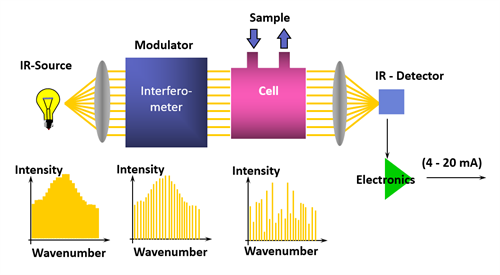Home
- Gas Analysis & Reporting
- Dust monitors
- Flow monitors
- Gas analysers
- Oxygen monitors
Condensate pumps- Coolers
- Filters
- Fittings
- Heated hoses
- Hoses
- Probes
- Sample gas pumps
- Test gasses
- Valves
Reconditioned products- Spare parts
- For analysers
- For gas conditioning
- Batteries
- Circuit boards
- Condensate pumps - spare parts
- Coolers - spare parts
- Filters - spare parts
- Fittings - spare parts
- Fuses
- Gaskets
- Heated hoses - spare parts
- Hoses - spare parts
- O-rings
- Other electrical
- Other mechanical
- PLCs
- Power supplies
- Probes - spare parts
- Relays
- Sample gas pumps - spare parts
- Sensors
- Test gasses - spare parts
- Tools
- Valves - spare parts
- Info pages

 The FTIR measuring principle is a measurement with IR light. Contrary to NDIR with a narrow wave length area by means of an optical filter, the scan area of the IR wave length by use of the FTIR measuring principle is large. The principle of FTIR is that the gas to be analysed is led through a cuvette with an IR light source at one end sending out scattered IR light, and a modulator that "cuts" the infra red light into different wave lengths. At the other end of the cuvette, a detector is measuring the amount of IR light to pass through the cuvette.
The FTIR measuring principle is a measurement with IR light. Contrary to NDIR with a narrow wave length area by means of an optical filter, the scan area of the IR wave length by use of the FTIR measuring principle is large. The principle of FTIR is that the gas to be analysed is led through a cuvette with an IR light source at one end sending out scattered IR light, and a modulator that "cuts" the infra red light into different wave lengths. At the other end of the cuvette, a detector is measuring the amount of IR light to pass through the cuvette.